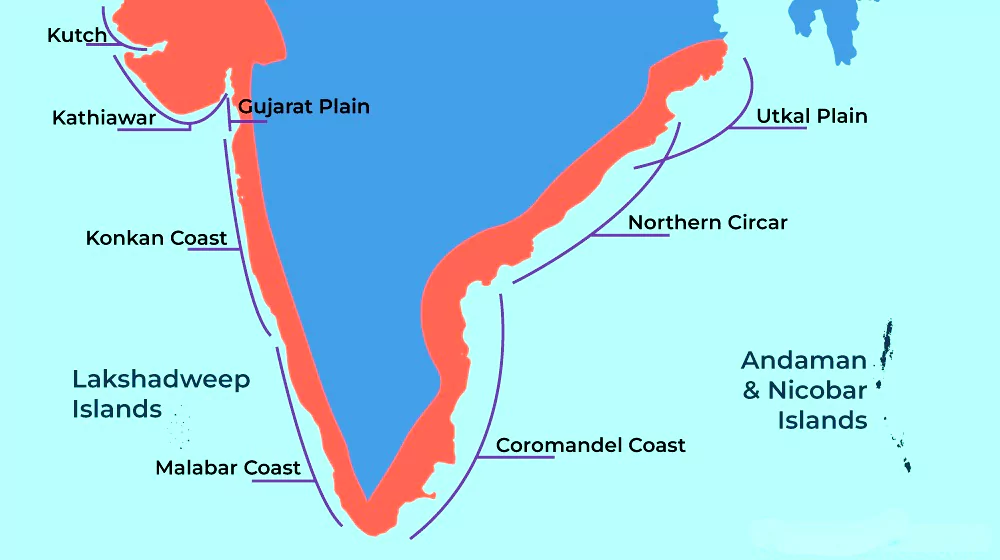India’s coastline has grown by 47.6%, from 7,516 km in 1970 to 11,098 km in 2023-24. The increase is due to the adoption of new methodologies for measuring coastal features.
Comparison: Old vs. New Measurement Methodology
| Aspect |
Old Methodology (1970) |
New Methodology (2023-24) |
| Basis of Measurement |
Straight-line distances |
Included complex coastal formations |
| Coastal Features Measured |
Limited to general shoreline length |
Incorporated bays, estuaries, inlets, and other geomorphological features |
| Technology Used |
Basic tools and manual calculations |
Advanced geospatial technologies and mapping tools |
| Accuracy |
Relatively less precise |
More precise representation of dynamic coastline |
| Reported Coastline Length |
7,516 km |
11,098 km |
Enroll now for UPSC Online Classes
Coastline Changes by States and UTs
-
States/UTs with Significant Growth
- Gujarat: Increased from 1,214 km (1970) to 2,340 km (2023-24).
- Accounts for the largest absolute growth in coastline length.Retains the position of the state with the longest coastline.
- West Bengal: Percentage increase of 357%, from 157 km to 721 km, marking the highest growth in percentage terms.
- Tamil Nadu: Revised length increased to 1,068 km from 906 km, overtaking Andhra Pradesh.
-
States/UTs with Minimal or Negative Changes
-
- Kerala: Recorded the smallest increase, adding only 30 km (5%).
- Puducherry: The coastline shrank by 4.9 km (-10.4%), due to erosion and recalculation.
- Tamil Nadu vs. Andhra Pradesh: Tamil Nadu now ranks higher than Andhra Pradesh in coastline length after the new measurement.
- Puducherry’s Contraction: Shrinkage attributed to erosion and refined calculations, contrasting the general trend of coastline growth elsewhere.

Impact of Coastline Expansion
- Economic Development
-
- Ports and Infrastructure: Andhra Pradesh is developing ports like Ramayapatnam, Krishnapatnam, and Kakinada Gateway to boost logistics, industrialization, and employment.
- Maritime Economy: Coastal states and UTs are leveraging expanded coastlines for enhanced maritime trade and tourism.
Coastlines of Emergence and Submergence
- Coastlines of Emergence: Occur when land is raised (uplifted) or when the sea level is lowered.
- Examples of features include bars, spits, lagoons, salt marshes, beaches, sea cliffs, and arches.
- Examples in India:
- Tamil Nadu Coast (Coromandel Coast)
- Kerala Coast (Malabar Coast)
- Coastlines of Submergence: Created when land is submerged due to subsidence or when the sea level rises.
- Examples in India:
- India’s West Coast: Displays both emergence and submergence.
- Northern Portion: Submerged due to faulting.
- Kerala Coast: An emerging section of the shoreline.
|
- Biodiversity and Environmental Considerations
-
- Expanded coastline data aids in better conservation of coastal biodiversity.
- Improved mapping supports monitoring coastal erosion and accretion.
- Policy and Planning: Accurate coastline data is crucial for maritime security, infrastructure planning, and disaster preparedness.
Check Out UPSC NCERT Textbooks From PW Store
Geographical Coverage of India’s Coastline
- Regions: Bordered by the Bay of Bengal (east), Indian Ocean (south), and Arabian Sea (west).
- States and UTs:
- Coastal states: Gujarat, Maharashtra, Goa, Karnataka, Kerala, Tamil Nadu, Andhra Pradesh, Odisha, and Bengal.
- UTs: Daman & Diu, Lakshadweep, Puducherry, and Andaman & Nicobar Islands.
![]() 9 Jan 2025
9 Jan 2025


